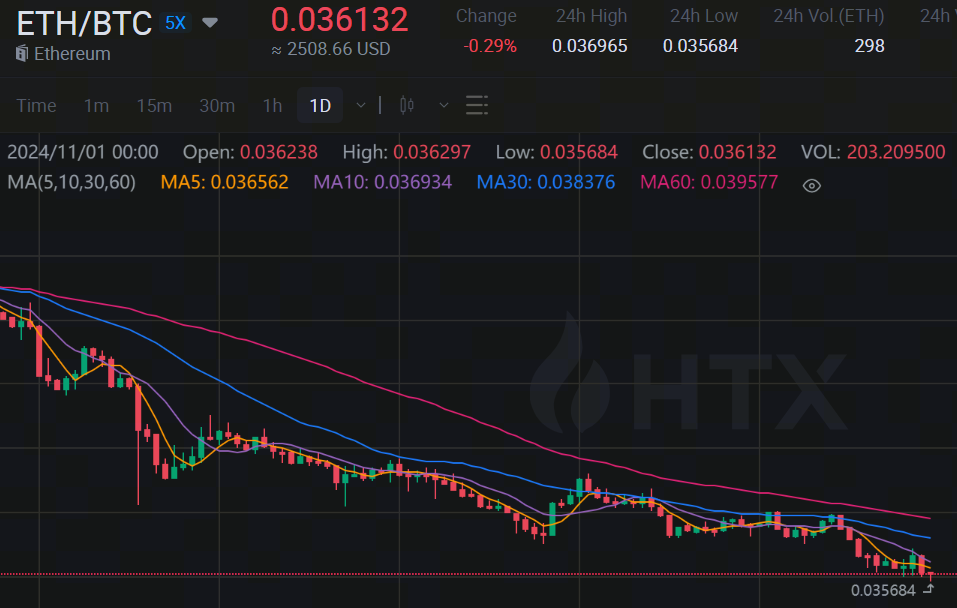
ETH/BTC’s performance since July. Source: HTX
Vitalik Buterin Speaks Up on Ethereum’s Future Amid Rising FUD
As concerns around Ethereum’s viability spread, Ethereum co-founder Vitalik Buterin has been increasingly vocal on X (formerly Twitter). Recently, he shared insights on Ethereum’s ambitious roadmap, outlining the steps of “Merge,” “Surge,” “Scourge,” “Verge,” “Purge,” and “Splurge.”
In his latest article, Possible Futures of the Ethereum Protocol, Part 6: The Splurge, he highlighted key goals of Ethereum, including:
● Bring the EVM to a performant and stable “endgame state”
● Bring account abstraction in-protocol, allowing all users to benefit from much more secure and convenient accounts
● Optimize transaction fee economics, increasing scalability while reducing risks
● Explore advanced cryptography that could make Ethereum far better in the long run
Addressing criticism of the Ethereum Foundation’s recent ETH sales, Vitalik made the following response:
“The ETH foundation is paying researchers and devs that are responsible for (i) ethereum not bleeding 5M ETH/year to proof of work; (ii) your fees being low today; (iii) your txs getting included in < 30s instead of like 1-30 min (eip 1559). Show some respect.”
Vitalik also noted that he hasn’t sold any ETH in the past month and has actually increased his holdings.
Crypto OG Du Jun weighed in, praising Ethereum but warning that the current deadlock is the mirror of the entire industry where outside payments, blockchain applications appear limited. This, of course, aligns with the original vision of Bitcoin’s white paper. “If memecoins and Tap2Earn are the future, the industry might as well give up,” he stated.
Analyzing the Core of Ethereum’s Current Slowdown
Web3 developer and researcher @web3_mario attributes Ethereum’s bottleneck to two main factors.
First, the rise of restaking protocols has diluted resources for mainstream Layer 2 developments, creating a “vampire attack” effect within the ecosystem. The fact that the nature of restaking does not generate demand for ETH, leading to attention diverted from Ethereum’s applications with stalled adoption and user education efforts.
Second, key Ethereum influencers have become insulated, forming a privileged class within the ecosystem. This has slowed developer incentives and stifled innovation.
However, @web3_mario maintains that Ethereum’s long-term fundamentals remain solid, as there are no direct competitors in the market. As he explains, in Ethereum’s “decentralized execution environment” narrative, decentralization is the core. So long as resources are aligned and application-building advances, Ethereum’s future should be bright.
Crypto KOL CM ( @cmdefi) also offered perspective, noting: “ETH is like a highway without traffic. Dissatisfied with the traffic lack, people blame the roadbuilders for being absorbed in their work. What we need are ‘car-makers’ while roadbuilders do not make any.” For CM, the market needs a community-driven movement similar to the DeFi and NFT boom rather than relying on Ethereum’s developers for progress. “No savior from on high delivers, and no faith have we in prince or peer.”
He argued that Ethereum has never truly grasped what users require and personally doesn’t regard DeFi and NFTs as groundbreaking innovations. The current FUD is mainly due to price stagnation, prompting users to seek reasons. Additionally, professional analysts may mistakenly treat the Ethereum Foundation as the sole leader of the Ethereum ecosystem as they view it as a company.
Crypto user @YeruiZhang offered another take, emphasizing that Ethereum’s price ultimately reflects supply and demand. In Zhang’s view, the ETH price rises when various demands spike, including application growth, wealth effect, locked on-chain supply, and macroeconomic conditions. But in recent cycles, Layer2s and other participants value Ethereum’s security with no ETH demand increase when the bull run is approaching. Roadmaps, tokenomics, performance improvements, composability, interoperability, dating, sell-offs, foundation style… all of these are distractions in the face of the fundamental supply and demand relationship.
Could ETH Still Stage a Comeback?
Crypto KOL Murphy believes ETH’s rally following BTC’s recent gains depends on capital inflow and blockchain activity.
Murphy highlighted his principles to intervene:
1. The trading volume of ETH on exchanges reaches 50% or more of BTC (currently 35%).
2. Maybe after 50%, the price of ETH will have gone up, but it will definitely not be the highest. For me, I need the confirmation signal of the trend first before executing my strategy.
3. The number of active on-chain addresses reflects the prosperity of the ETH ecosystem to a certain extent, and it is necessary to see a sustained increase.
4. The transfer counts and transaction volumes should be magnified simultaneously, especially the latter, an important signal to measure large transactions.
Benjamin Cowen, CEO of ITC Crypto, expressed, “In 2016, ETH had big drops in April, August, and December. In 2024, ETH has had big drops in April and August. So a decent chance it plays out in a similar fashion, with one more drop by ETH before EOY, with the low in December.”
Underperformance, objectively, doesn’t always signal trouble. With strong fundamentals and a positive outlook, a crypto may imply untapped potential. This seems to fit a broader trend across altcoins, which could shift when the “altcoin season” begins.
The post first appeared on HTX Square.

